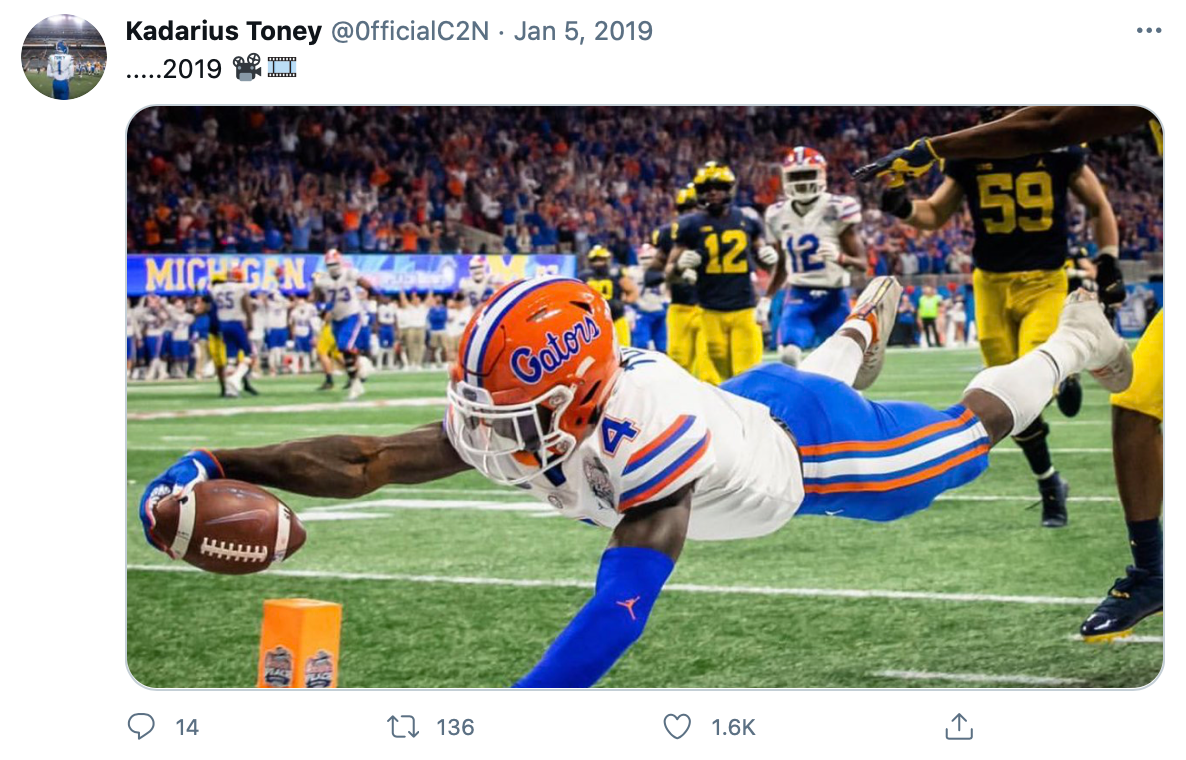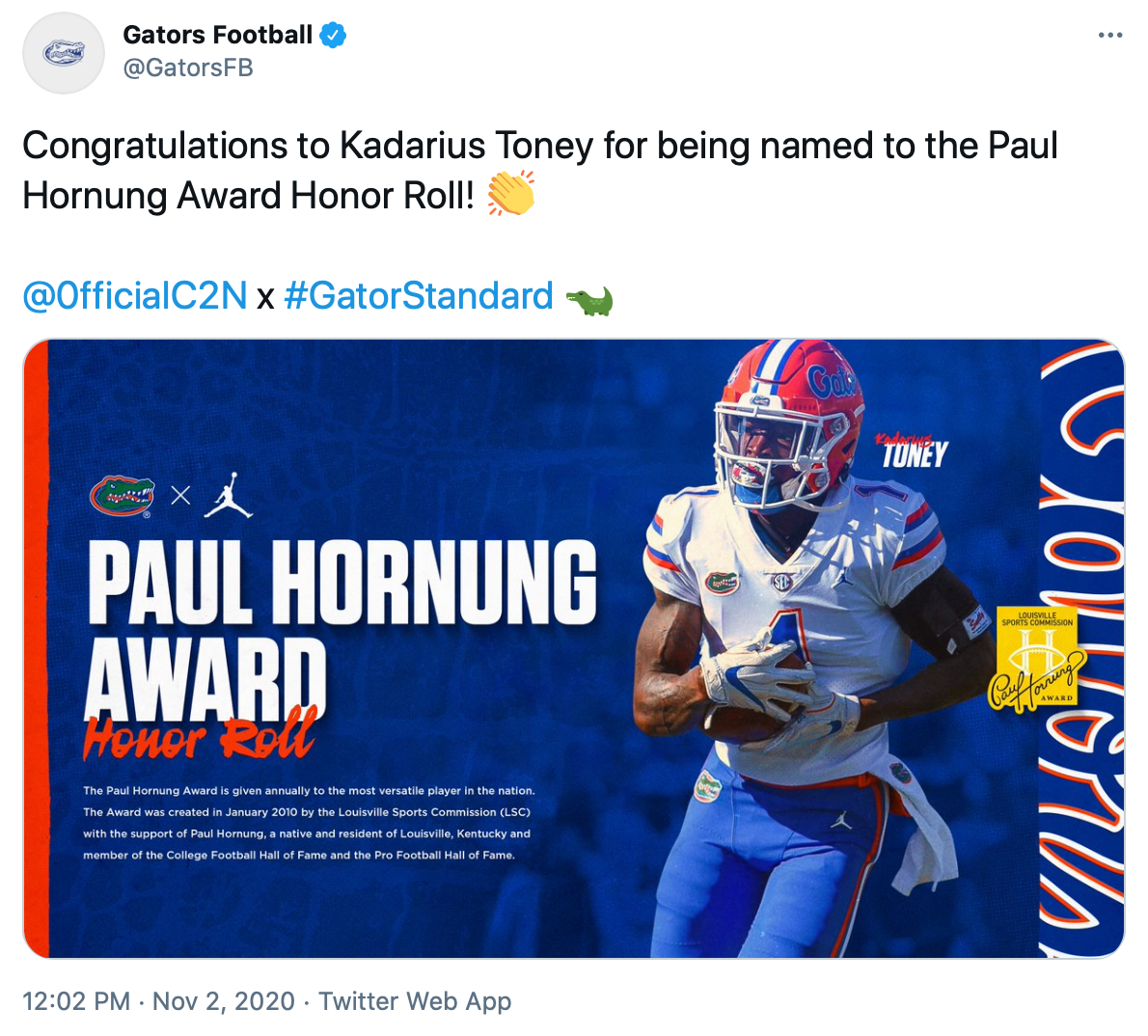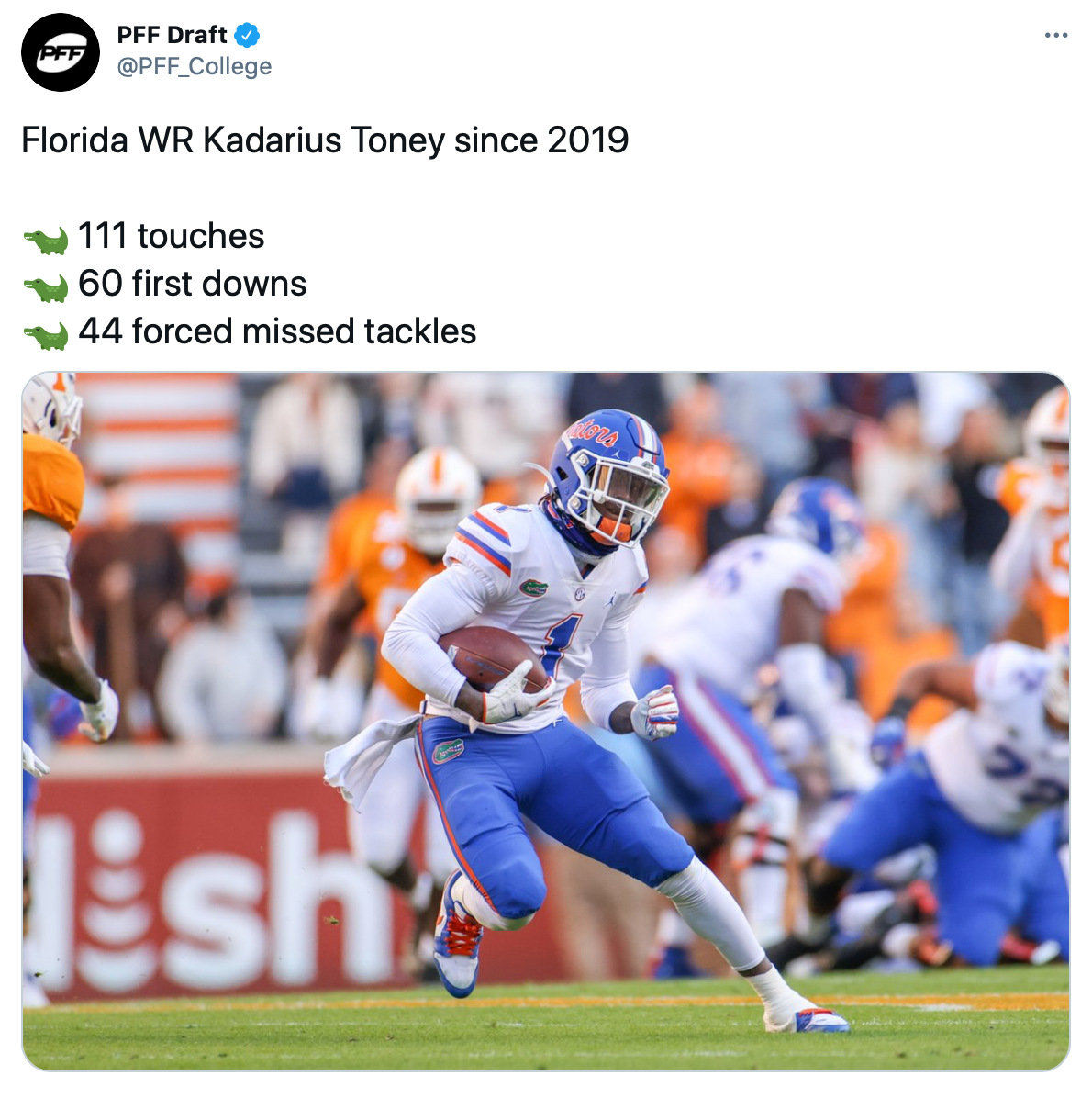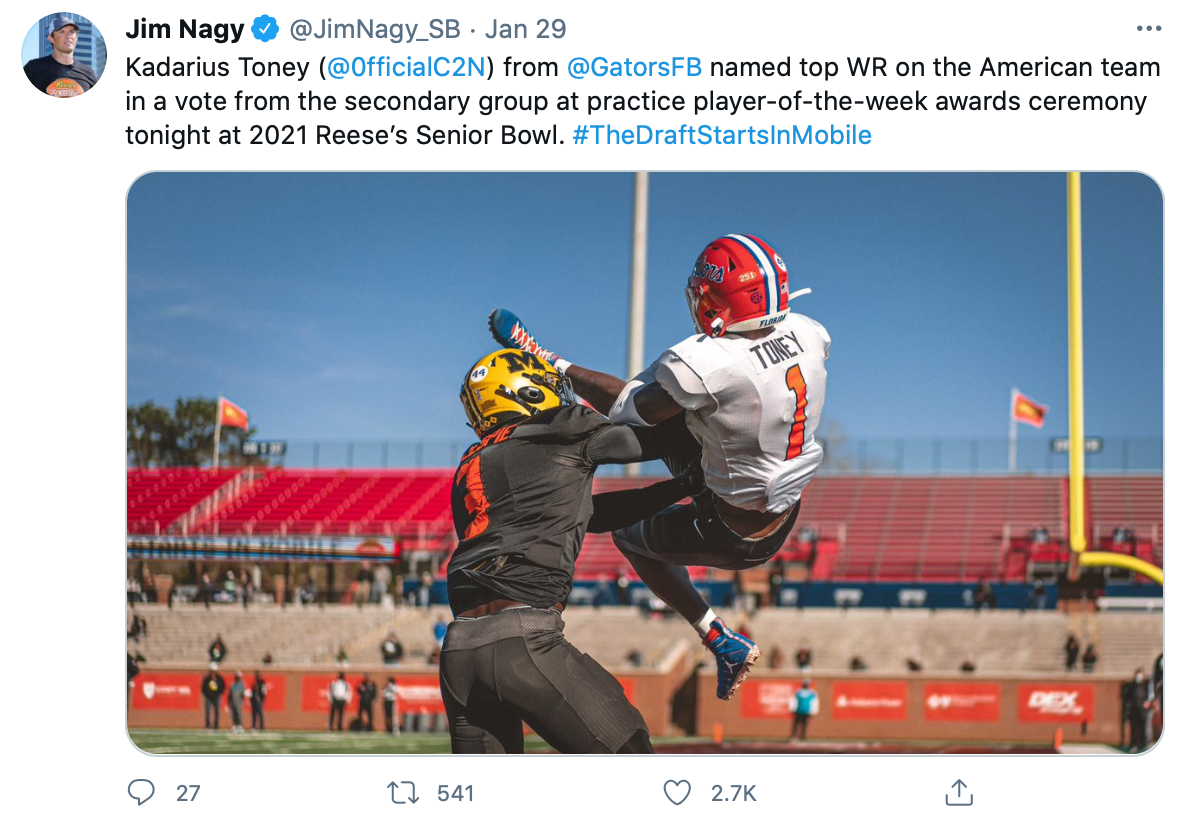Kadarius Toney
WR | Florida Gators | 5-11 | 189 lbs.
Rookie Expectations
Over the last three NFL seasons, wide receivers who predominantly lined up on the outside have run five particular routes for about 75% of total routes. Those five routes are Gos, Hitches, Outs, Slants, and Crossers. For WRs playing from the slot, these five routes are also featured, at slightly altered percentages, for a nearly identical combined total. The final 25% will be distributed among Ins, Posts, Corners, some Screens, and the rest on exotic combo routes when split wide. For slot WRs, the majority of that 25% will go toward Screens and shallow work in the flat. Whenever I make references to “NFL routes” in these Dyno rookie profiles, those are the guidelines I am following.
The Story
Growing up in Alabama, Kadarius Toney’s parents shielded him from sports early on, worried it would lead to injury. But when his father finally allowed him to try football, Toney never stopped. No matter if it was his PeeWee team or at Blount High School, Toney’s coaches would always want him at QB — a high football IQ could be the culprit. After putting his everything into the QB position, his transition to the Power Five ultimately came with the realization that his calling would be at WR.
During his true freshman, age-18 season, K.T. still really wanted to play QB. (Florida fans agreed, as the Gators had a long struggle at QB in the post Tim Tebow era.) But Toney also wanted to be on the field, no matter the position — and his athleticism was undeniable. There was also the, erm, minor issue of Toney not having a single idea how to run his routes, how to get off press coverage, or how to get open. When he began his conversion to a wideout, Jim McElwain was the head honcho, Doug Nussmeier was calling the plays, and Kerry Dixon II was in charge of instructing his WRs.
On the 2017 preseason release of the depth chart, Toney’s name was listed behind Brandon Powell and Dre Massey at slot. However, K.T. would end up catching all 15 of passes lined up out wide, and where he would run nearly 95% of his routes. But he would play a good amount as the Wildcat QB. When Dan Mullen was hired as the new head coach in Gainesville in 2018, he brought along his trusted team of coaches including OC Brian Johnson and WR coach Billy Gonzales. The official depth chart that season had Toney listed behind Tyrie Cleveland and Massey… on the outside. Mullen would even express that he wasn’t quite sure how he would use Toney just yet, listing Kadarius as an “athlete” on the official roster.
It was under Gonzales when Toney would learn the nuances and foot movement to play the position. He would finally learn how to get open by simply completing his routes properly. Instead of using his explosive, inventive moves to separate, the actual route would create room, and then allow Toney to use jukes to great effect. At the conclusion of his second season in Gainesville, K.T. split his time evenly between the slot and wide. But his slot work especially stood out, with a 48% increase in per route production over wide. His lightning-fast feet also made him a monster when set in pre-snap motion.
Looking back at his true sophomore season, one game stands out the most. In Week 10, the Gators hosted Missouri at The Swamp. After taking a difficult 36-17 defeat on the road to Georgia the previous week, the Gators would fall behind 35-10 to the Tigers midway through the third quarter. Unfortunately, QB Feleipe Franks never quite found his footing with UF. Franks would be replaced in that third quarter by an unheralded redshirt sophomore prospect, Kyle Trask. Trask would lead the offense 75 yards down the field to score on a TD pass to Josh Hammond on his very first drive. Trask would close out the losing effort with a 45-yard connection to Toney, clip referenced below, on the final of his three drives.
The Trask-to-Toney chemistry was immediate and undeniable.
The following season facing Kentucky in Week 3, Franks’ attempt to scramble away from pressure would end in a fractured ankle. Franks came to Florida with loads of potential that wouldn’t come to fruition until the following season after transferring to Arkansas. But his absence would result in opportunity for Trask. While Trask would need to wait until Week 11 for Toney to return from a bum shoulder injured facing UT-Martin, that previous chemistry would make an immediate return. If we extrapolate his rate of production with Trask during his true junior season using his 2020 snap rate over the full season, Toney would’ve been on pace for 76 receptions, 1,470 yards, and eight TDs in 2019. Wow!
Which brings us to his 2020 “breakout” season. Breakout in the sense that the actual production finally matched up with what we already saw in flashes. Outside of working with Trask, the other factor that resulted in Toney’s ascension was finally having his time committed to the slot. In 2019, his yardage per route increased by 70% when in the slot over wide. And he would run over 90% of his routes from the slot that season. That defined role would continue during his final season in The Orange and Blue.
The Attributes
Since K.T. played exclusively at QB while at Blount High School, the only allure to viewing the footage is to see the same explosive running style we can see from his UF footage. That explosion was put on display during The Opening Regionals in 2016, his age 17 season, when Toney would register an otherworldly 41.4-inch vertical. However, he would also be timed with a 4.69 second 40-yard dash, and an alarming 4.43 short shuttle. Should we be concerned? The 40 time can completely be forgotten. When we have proven Power Five production in hand, we must have up-to-date 40 times in order to draw any conclusions.
As for the short shuttle, I should be on the fence. I use short-shuttle times as a tool to evaluate body control. Granted, I feel it is far more important at RB, but that it is also far more important at slot WR than at X or Z. That said, what we’ll see from him on tape will eliminate any concerns.
Let’s begin our film review of Toney with a very brief examination of his ‘17 season. At the 0:07 mark, we get to see Toney at Wildcat QB, slicing through, ironically, the Wildcats toward paydirt. The basketball-style wiggle is there from Day 1. Further Wildcat examples are shown at 0:31, 1:08, 1:29, and 2:18. At 0:24, we can plainly see that Toney has no idea what he’s doing from a route-running perspective on what appears to be an inside-release Go route. But we do see the strong hands that would drop just three-of-150 targets, and lost only two fumbles on 223 touches, over his career.
Pay particular attention to Toney at 0:37 and 0:44 on designed screens. As an NFL rookie, slot receivers will be expected to do 56% more work in the flats than out wide. So much, in fact, that we can expand upon the five NFL routes to include flat work as the sixth route. Toney’s ability to chain together moves is on display, turning what should’ve been a four-yard gain into a first down on the first example. On the second, he reverses field for big yardage. Let’s move ahead to his true sophomore, Age 19 season with this video.
The first two examples see Toney running fundamental hitches with very short stems. The purpose of the hitch is to attack the underbelly of soft coverage, or to make defensive backs pay for an overaggressive approach. Some call for specific timing, others are designed to push the route downfield to just under the defender. But, we can see these two hitches are neither. They are simply short stops to quickly get the ball into his hands. We also see that sexy elusiveness forcing a trio of missed tackles. Quick strikes to the flat will be a common occurrence for Toney during his career, you can find more designed screen examples at 3:26 (RPO) and 3:52.
At 0:20 in the film, Toney is using his abilities again as the Wildcat QB. The role that he would play on more than 30 occasions his first two seasons would only be used once his final two… coincidentally coinciding with his route-running development. Toney is the type of athlete able to completely abandon his designed blocking to turn a profit at the college level. Nonetheless, unless he tests out with Tyreek Hill’s speed at his Pro Day, which I entirely doubt, he will need to avoid making these decisions, and trusting in his blocking at the next level. Additional snaps as the Wildcat QB can be found at 0:49 and 1:14.
The other gadget designs Brian Johnson used to put the ball in his hands were on Jet Sweeps and Reverses. At 0:39 we see one of Toney on a Reverse. Two seasons removed from that 4.69 40 time does seem to be a distant memory. While it’s not the official definition of a Jet, the tricky handoff at 1:07 actually fits the translation I was taught while at PFF. You can find further illustrations of Toney on these trick plays at 1:24, 4:23, and 5:28.
We will likely see Toney utilized on special teams as a returner in the NFL. The 2018 season, his first as the primary kick returner at Florida, served as a prelude to taking on the role on both kickoffs and punts during his senior season. At 2:05 facing Georgia, we see Toney using his hip and knee wiggle on a kickoff return. One detail on the play that stands out is a slight hitch in his running style. It could be nothing, but it could also be a slight explanation for his previously poor athletic timings.
One of the only positive throws from Franks in the game, the Back Shoulder Go at 2:32 against Missouri stands as an excellent sign of Toney becoming more comfortable as a WR. As previously mentioned, we see Trask connect with K.T. at 2:53 down the seam for that 45-yarder. In spite of the growth we’ve seen, the Sluggo route variant at 4:49 facing Idaho is sloppy, to say the least. Trask finds him again down the seam at 5:07, further proof of his ball security, but does allow the ball into his body.
We don’t have much to view from an injury-shortened ‘19 season. We’ll use this video to break it down. Right off the bat, Toney is fed on a designed screen. We still see that slight rocking motion in his running style on his only touch facing Miami (FL) the opening weekend. Additional screens are shown at 0:58 and 2:32. At the 0:33 mark, Toney’s number is called on another trick play. His ability to force missed tackles is truly special at the position. We are shown K.T. on a “Jet” with the QB under center at 1:08. A traditional Jet is shown at 1:51. On a poorly underthrown ball into Cover 3 from Emory Jones (1:37), Toney adjusts his route down the seam, and uses the bad throw to avoid defenders.
To conclude our film review on Toney, let’s use this footage to break down his tremendous true senior season. The opening clip finds Toney being handed the ball from Trask under center on another of those exotic “Jets.” The biggest takeaway for me here is that running hitch appears to be completely absent. It may not seem like much, but it could be the difference in millions of dollars for the kid.
Of course, the immensely important flat work continues to be a big part of his game. We see Kadarius at 1:03 on a quick out to the left flat, and then another at 4:03. Then we have the designed screens. Slots are the only WRs where we can actually use screen yardage in their evaluation due to it translating to the NFL game. At the 2:10 mark, it sure does seem as though Toney breaks tackles from the entire Missouri defense on his way into the end zone. Other fine examples on designed screens can be found at 7:13 against LSU, and facing Alabama in the SEC Championship at 7:45 and 8:22.
I really want to dissect Toney’s route running for you from this footage. At 0:16 facing a porous Ole Miss secondary, K.T. uses a “64R,” hitch-in, to pick up the first, also shown at 5:45. This is a route used specifically to freeze CBs. We see another pattern with similar function on Whips at 0:28 and 5:13. These are distinct tells that Toney has grown entirely comfortable with the receiving route tree. Moving ahead to 0:54, Toney shows us one of the first examples on an NFL route, specifically an Out; an additional can be found at 6:47.
A second NFL route we want to see is the slant. We get our first at 1:12 (another at 5:24), completely spinning SC CB Shilo Sanders around before racing through three tackle attempts to the house. Again, no sign of that running hitch. Aggies LB Buddy Johnson is completely out of his depth in zone coverage of Toney on a sharp Dig/In (1:51). Facing what appears to be a Georgia Cover 4 (3:01), Toney shows off a nice highpoint on a crosser, a third NFL route.
As already discussed, Toney shredded college defense with pre-snap motion. Gaze your eyes upon how deadly he becomes in motion at 2:24. Providing him with that head start is truly lethal. Perhaps no other play from the season has received more press, rightfully so, to an extent, is the right slide with pre-snap motion at 5:56. It’s important in that it bolsters belief in further use of Toney in motion. Although, Toney was rarely used in goal-to-go situations. It’s one of only two such career receptions. He’s just not that type of receiver.
One of the most significant improvements made by Toney during his senior season was in dealing with man coverage. At 0:36 facing the Rebels in Cover-2 Man, Toney takes advantage of A.J. Finley on a post for the score. Trask finds K.T. on a deep crosser (1:28) with Texas A&M’s Leon O'Neal Jr. helplessly trailing behind. He’ll be asked to run far fewer Go’s, a fourth NFL route, at the next level, but we have a fine example at 1:44 cruising past O’Neal, once again, in Cover 1. Toney completely jukes Vandy’s Jaylen Mahoney out of his shoes on another Go at 4:20.
In what appears to be Cover 2-Man, Toney leaves UGA CB Mark Webb in the dust on his new-and-improved hitch, the fifth-and-final NFL route we want to see (more shown at 3:22, 3:44, 3:55, and 5:05). Saving some of his best work for his final two games, Toney blazes right past LSUs Cordale Flott down the seam at the 6:19 mark. We continue to see Toney stringing together NFL-level moves on the run shown at 6:29. Toney exploits athletic true freshman CB Dwight McGlothern on another crosser at 7:01. This is the second-best example on this video of Toney’s improved speed.
The one play that I feel best proves Toney will test out fast at his Pro Day is found at 7:37. Alabama’s Malachi Moore is completely unprepared for what happens on this boundary Go. With Toney in motion — queue the eerie music — at 8:00, Jordan Battle is taken to the cleaners down the seam. With the Tide in a Cover 4, Moore is once again a victim of Toney (8:09), this time on a quick out-and-up from the backfield, no less.
Fantasy Fit
Let me first state that we know K.T. is not a QB or RB, and) he’s not an X or Z (and he’s also not a threat to his community in spite of his air rifle hijinks early in his UF career). What Toney is is an elite athlete, a future NFL slot, and likely teetering as a late-first, early second-round pick. As I do when for all of my film research, I begin with an open mind on a player’s evaluation. I avoid all outside influences, and focus entirely on the tape and analytics. His true freshman footage really concerned me. His route running nuance was almost nonexistent, and the awkward hitch in his running style was offputting. By Year 2, we could see some gradual improvements, but the hitch remained.
We really couldn’t take that much away from his junior season, as there’s just not much there. But his senior film blew me away. It’s truly a different player. He’s alway had an elite skillset with the ball in his hands. But I was not expecting to see the crispness of his route running so quickly. And I would not be surprised one bit to learn that Toney and Kyle Pitts trained together prior to the 2020 season. Working side-by-side with a generational athlete such as Pitts could have lit the fire that melted K.T. down into the example we see today.
As for NFL fits, Toney doesn’t need to “fit” a team's style to translate his abilities. But the Ravens, Bears, Titans, obviously the Lions, Patriots and Eagles, as well as the 49ers instantly scream need for someone of his talents. The Chiefs and Chargers stand out as two of the sexier landing spots. But the Vikings might be the team I would most want to see snag Toney. K.T. put some tremendous examples together in utter destruction of man coverage his senior season. And no other QB in the NFL can do what Kirk Cousins can to a Cover 1.
In order to make a confident comparison of Toney side-by-side with an NFL WR, I need trustworthy athletic testing to envision a future. With that in mind, I’ll avoid “comp”ing Toney at this time.
The Bottom Line
Prior to going back through his footage, I was unsure where I would rank Toney among the WR, rookie class. After evaluating his film, however, he has jumped over four other players to land as No. 10 on my rookie draft big board. The most significant of the players he passed up is LSU WR Terrace Marshall Jr. In Marshall’s defense, I’ve yet to evaluate his film. But the traits Toney showed off left quite an impression on me.
K.T. is going to be selected early in the 2021 NFL Draft. That much is certain. With that in mind, we also know he will receive a significant opportunity wherever he lands. As it stands, I have Ja’Marr Chase, DeVonta Smith, Jaylen Waddle, Amon-Ra St. Brown, and Rashod Bateman ahead of him. And I will be drafting him as such, sans Superflex formats, in my rookie drafts.











